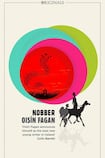
Oisín Fagan’s debut novel is set in 14th-century Ireland and tells of four intrepid chancers – a nobleman called Osprey de Flunkl and his underlings William, Harold and Saint John – who scope out plague-ravaged towns in the hope of acquiring properties on the cheap. They alight on a small town called Nobber; it is “overflowing with death”, its shut-up houses resembling “closed oysters”. Here they encounter a large, sinister structure of unknown provenance: it is made up of dozens of crows nailed to a kind of crucifix, some of them still alive. The men are duly spooked: one observes that it is “deeply weird”; another remarks, “I do not know what it intends to portray . . . but whatever it is that it does portray, it portrays it very mightily.” While the “thing of crows” looms portentously in the background, de Flunkl and his retinue acquaint themselves with the locals – who, it turns out, are every bit as weird.
Perception of ‘perversions’
Prominent among these is a blacksmith called Colca, who has a reputation for bestiality and is, as a result, struggling to find work as a farrier. In one deliciously daft scene, he reassures his heartbroken mother that the public perception of his “perversions” is exaggerated, and he does not have sex with animals nearly as often as people think: a neighbour “accused me of soliciting her goats . . . but it was not true; I was merely playing with their ears, making them wear little hats.” Some of the townspeople seem to have been driven insane by the contagion. One woman butchers a horse with a meat cleaver and immediately loses all memory of having done so. When it is put to her that was the culprit, she protests: “You will not put this death on me . . . I do not even ride.” Elsewhere we meet a peasant woman with a wide cleft lip: “When this woman opens her mouth, it is as though she has a second smaller mouth hidden inside it.”
Loquacious putdowns
Because it is the 14th century, narration and dialogue alike are delivered in a parodically mannered, ye-olden-times register: people don’t just look at things but “regard” them; a home is an “abode”; things are not done promptly but “with promptitude”; and so on. Fagan’s characters do a fine line in loquacious putdowns. De Flunkl snaps at Harold: “My, you bore me. Even nothing is less boring than you are.” A woman tells de Flunkl: “I hate your boyish face; it fills me with disgust. I will retch momentarily as it would seem I am forced to regard it.” The novel opens with a bizarre slanging match between de Flunkl’s men and a band of Gaels, who brag aggressively about the fecundity and large labia of their womenfolk. Fertility is something of a recurring theme, even cropping up in the descriptive imagery on occasion. Here, for example, is Colca is emerging from a dark doorway in the nude: “Naked as he is, it seems as though the house is giving birth to him.”
This is all tremendously good fun: if noir whimsy and highfalutin’ bawdiness are your thing, you will find a chortle-worthy moment on every couple of pages. Less hedonistic readers may be left scratching their heads in bemusement: what, they might very well ask, is the point of it? As a work of narrative fiction resembling a cross between a medieval picaresque, a children’s adventure story and one of the “historical” Carry On films, Nobber occupies the intersection of a Venn diagram nobody even knew existed. Fagan is a skilled storyteller with a rich command of language and rare comedic flair. One hopes he is able to put his considerable talents to more constructive use in future.











